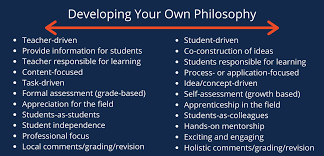“`html
Exploring Teaching Philosophy Examples
Developing a teaching philosophy is essential for educators to articulate their beliefs, values, and approaches to teaching. A teaching philosophy serves as a guiding framework that informs instructional practices and interactions with students. Let’s explore some examples of teaching philosophies that educators may adopt:
Example 1: Student-Centered Approach
This philosophy prioritizes the needs and interests of students. Educators following this approach believe in creating a supportive learning environment where students are actively engaged in the learning process. They emphasize personalized instruction, collaborative activities, and student empowerment.
Example 2: Constructivist Perspective
Constructivist educators believe that learning is an active process where students construct knowledge through experiences and interactions. They encourage hands-on activities, critical thinking, and reflection to help students build their understanding of concepts. This philosophy values student autonomy and exploration.
Example 3: Social Justice Orientation
Educators with a social justice orientation are committed to addressing inequities in education and society. They strive to create inclusive classrooms where all students feel valued and respected. This philosophy emphasizes diversity, equity, and advocacy for marginalized populations.
Example 4: Experiential Learning Emphasis
This philosophy focuses on providing real-world experiences to enhance learning outcomes. Educators who emphasize experiential learning incorporate hands-on projects, internships, field trips, and simulations into their curriculum. They believe that practical application deepens understanding and fosters skill development.
In conclusion, teaching philosophies vary based on individual beliefs and educational goals. By reflecting on different examples of teaching philosophies, educators can refine their own approach to teaching and create meaningful learning experiences for their students.
“`
5 Effective Tips for Teaching Philosophy: Engaging Students with Real-Life Examples and Diverse Perspectives
- Use real-life examples to make abstract concepts more relatable.
- Encourage students to think critically by asking open-ended questions.
- Provide a variety of philosophical examples from different time periods and cultures.
- Create opportunities for students to engage in philosophical discussions and debates.
- Incorporate multimedia resources such as videos or podcasts to enhance learning experiences.
Use real-life examples to make abstract concepts more relatable.
“`html
One effective tip when developing a teaching philosophy is to use real-life examples to make abstract concepts more relatable to students. By connecting theoretical ideas to practical, everyday situations, educators can help students grasp complex concepts more easily. Real-life examples not only enhance understanding but also make learning more engaging and relevant. This approach allows students to see the relevance of what they are learning and how it applies to their lives, fostering deeper comprehension and retention of knowledge.
“`
Encourage students to think critically by asking open-ended questions.
“`html
Encouraging students to think critically by asking open-ended questions is a powerful strategy in teaching. By posing questions that do not have a single correct answer, educators prompt students to analyze, evaluate, and synthesize information. This approach fosters deep learning and encourages students to explore diverse perspectives and develop their problem-solving skills. Open-ended questions also promote active engagement in the learning process, as students are challenged to articulate their thoughts and justify their reasoning. Ultimately, this practice cultivates a classroom environment where curiosity thrives, and students become more independent and analytical thinkers.
“`
Provide a variety of philosophical examples from different time periods and cultures.
“`html
When developing a teaching philosophy, it is valuable to provide a variety of philosophical examples from different time periods and cultures. By exploring diverse perspectives on education from various historical eras and global contexts, educators can gain a richer understanding of the underlying principles and beliefs that shape teaching practices. Incorporating philosophical examples from different cultural backgrounds not only promotes inclusivity and diversity in education but also encourages educators to critically examine their own assumptions and biases. This broadened perspective can lead to a more comprehensive and well-rounded teaching philosophy that resonates with a wide range of students and fosters a more inclusive learning environment.
“`
Create opportunities for students to engage in philosophical discussions and debates.
“`html
Encouraging students to engage in philosophical discussions and debates is a valuable strategy to foster critical thinking and deepen their understanding of complex ideas. By creating opportunities for students to explore different perspectives, analyze arguments, and articulate their thoughts, educators can cultivate intellectual curiosity and communication skills. These discussions not only enhance students’ ability to think critically but also promote active participation and collaborative learning in the classroom. Through philosophical dialogues, students can develop a deeper appreciation for diverse viewpoints and learn how to construct well-reasoned arguments, preparing them for academic success and lifelong learning.
“`
Incorporate multimedia resources such as videos or podcasts to enhance learning experiences.
“`html
Enhancing learning experiences through multimedia resources such as videos or podcasts is a valuable tip in developing a dynamic teaching philosophy. By incorporating multimedia elements into lessons, educators can cater to diverse learning styles and engage students through visual and auditory stimuli. These resources not only make learning more interactive and engaging but also help reinforce key concepts in a memorable way. Integrating videos or podcasts into teaching practices can inspire curiosity, spark discussions, and provide real-world examples that enrich the educational experience for students.
“`

